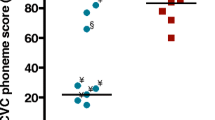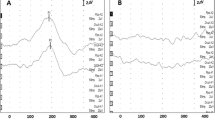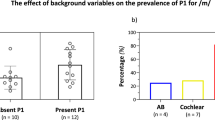Abstract
Auditory stimulation during childhood is critical for the development of the auditory cortex in humans and with that for hearing in adulthood. Age-related changes in morphology and peak latencies of the cortical auditory evoked potential (CAEP) have led to the use of this cortical response as a biomarker of auditory cortical maturation including studies of cortical development after deafness and subsequent cochlear implantation. To date, it is unknown whether prelingually deaf adults, with early onset deafness (before the age of 2 years) and who received a cochlear implant (CI) only during adulthood, would display absent or aberrant CAEP waveforms as predicted from CAEP studies in late implanted prelingually deaf children. In the current study, CAEP waveforms were recorded in response to electric stimuli in prelingually deaf adults, who received their CI after the age of 21 years. Waveform morphology and peak latencies were compared to the CAEP responses obtained in postlingually deaf adults, who became deaf after the age of 16. Unexpectedly, typical CAEP waveforms with adult-like P1-N1-P2 morphology could be recorded in the prelingually deaf adult CI users. On visual inspection, waveform morphology was comparable to the CAEP waveforms recorded in the postlingually deaf CI users. Interestingly, however, latencies of the N1 peak were significantly shorter and amplitudes were significantly larger in the prelingual group than in the postlingual group. The presence of the CAEP together with an early and large N1 peak might represent activation of the more innate and less complex components of the auditory cortex of the prelingually deaf CI user, whereas the CAEP in postlingually deaf CI users might reflect activation of the mature neural network still present in these patients. The CAEPs may therefore be helpful in the assessment of developmental state of the auditory cortex.







Similar content being viewed by others
References
Alvarenga KF, Amorim RB, Agostinho-Pesse RS, Costa OA, Nascimento LT, Bevilacqua MC (2012) Speech perception and cortical auditory evoked potentials in cochlear implant users with auditory neuropathy spectrum disorders. Int J Pediatr Otorhinolaryngol 76:1332–1338
Cardon G, Sharma A (2013) Central auditory maturation and behavioral outcome in children with auditory neuropathy spectrum disorder who use cochlear implants. Int J Audiol 52:577–586
Dorman MF, Sharma A, Gilley P, Martin K, Roland P (2007) Central auditory development: evidence from CAEP measurements in children fit with cochlear implants. J Commun Disord 40:284–294
Doucet ME, Bergeron F, Lassonde M, Ferron P, Lepore F (2006) Cross-modal reorganization and speech perception in cochlear implant users. Brain 129:3376–3383
Eggermont JJ, Ponton CW (2003) Auditory-evoked potential studies of cortical maturation in normal hearing and implanted children: correlations with changes in structure and speech perception. Acta Otolaryngol 123:249–252
Friesen LM, Picton TW (2010) A method for removing cochlear implant artifact. Hear Res 259:95–106
Gordon KA, Tanaka S, Wong DDE, Papsin BC (2008) Characterizing responses from auditory cortex in young people with several years of cochlear implant experience. Clin Neurophysiol 199:2347–2362
Huttenlocher PR, Dabholkar AS (1997) Regional differences in synaptogenesis in human cerebral cortex. J Comp Neurol 387:167–178
Innocenti GM, Price DJ (2005) Exuberance in the development of cortical networks. Nat Rev Neurosci 6:955–965
Jiwani S, Papsin BC, Gordon KA (2013) Central auditory development after long-term cochlear implant use. Clin Neurophysiol 124:1868–1880
Klop WM, Briaire JJ, Stiggelbout AM, Frijns JH (2007) Cochlear implant outcomes and quality of life in adults with prelingual deafness. Laryngoscope 117:1982–1987
Kral A, Eggermont JJ (2007) What’s to lose and what’s to learn: development under auditory deprivation, cochlear implants and limits of cortical plasticity. Brain Res Rev 56:259–269
Kral A, O’Donoghue GM (2010) Profound deafness in childhood. N Engl J Med 363:1438–1450
Kral A, Sharma A (2012) Developmental neuroplasticity after cochlear implantation. Trends Neurosci 35:111–122
Kral A, Tillein J, Heid S, Klinke R, Hartmann R (2006) Cochlear implants: cortical plasticity in congenital deprivation. Prog Brain Res 157:283–313
Lee HJ, Giraud AL, Kang E, Oh SH, Kang H, Kim CS, Lee DS (2007) Cortical activity at rest predicts cochlear implantation outcome. Cereb Cortex 17:909–917
Martin BA, Tremblay KL, Korczak P (2008) Speech evoked potentials: from the laboratory to the clinic. Ear Hear 29:285–313
Näätänen R, Picton T (1987) The N1 wave of the human electric and magnetic response to sound: a review and an analysis of the component structure. Psychophysiology 24:375–425
Pascual-Marqui RD (2002) Standardized low-resolution brain electromagnetic tomography (sLORETA): technical details. Methods Find Exp Clin Pharmacol 24(Suppl D):5–12
Ponton CW, Eggermont JJ (2001) Of kittens and kids: altered cortical maturation following profound deafness and cochlear implant use. Audiol Neurootol 6:363–380
Ponton CW, Eggermont JJ, Kwong B, Don M (2000) Maturation of human central auditory system activity: evidence from multi-channel evoked potentials. Clin Neurophysiol 111:220
Sharma A, Kraus N, McGee TJ, Nicol TG (1997) Developmental changes in P1 and N1 central auditory responses elicited by consonant-vowel syllables. Electroencephalogr Clin Neurophysiol 104:540–545
Sharma A, Dorman MF, Spahr AJ (2002) A sensitive period for the development of the central auditory system in children with cochlear implants: implications for age of implantation. Ear Hear 23:532–539
Teoh SW, Pisoni DB, Miyamoto RT (2004) Cochlear implantation in adults with prelingual deafness. Part I. Clinical results. Laryngoscope 114:1536–1540
Uhlhaas PJ, Singer W (2011) The development of neural synchrony and large-scale cortical networks during adolescence: relevance for the pathophysiology of schizophrenia and neurodevelopmental hypothesis. Schizophr Bull 37:514–523
Versfeld NJ, Daalder L, Festen JM, Houtgast T (2000) Method for the selection of sentence materials for efficient measurement of the speech reception threshold. J Acoust Soc Am 107:1671–1684
Wunderlich JL, Cone-Wesson BK (2006) Maturation of CAEP in infants and children: a review. Hear Res 212:212–223
Wunderlich JL, Cone-Wesson BK, Shepherd R (2006) Maturation of the cortical auditory evoked potential in infants and young children. Hear Res 212:185–202
Acknowledgments
The authors thank all the participants for their time and support and the members of the Cochlear Implant Team of the UMC Utrecht for their contributions. This study is supported by an unrestrictive research grant from Cochlear Ltd.
Conflict of Interest
Wilko Grolman received an unrestrictive research grant from Cochlear Ltd. for this study. Wilko Grolman received unrestrictive research grants from MED-EL GmbH and Advanced Bionics. No competing interests declared by the other authors.
Author information
Authors and Affiliations
Corresponding author
Rights and permissions
About this article
Cite this article
Lammers, M.J.W., Versnel, H., van Zanten, G.A. et al. Altered Cortical Activity in Prelingually Deafened Cochlear Implant Users Following Long Periods of Auditory Deprivation. JARO 16, 159–170 (2015). https://doi.org/10.1007/s10162-014-0490-8
Received:
Accepted:
Published:
Issue Date:
DOI: https://doi.org/10.1007/s10162-014-0490-8




